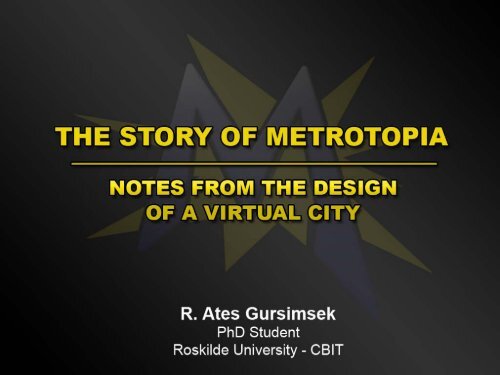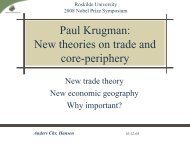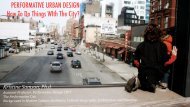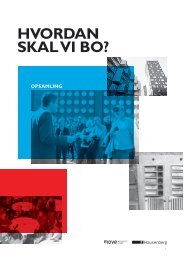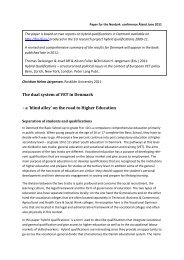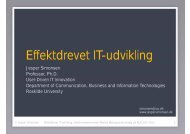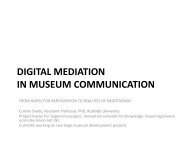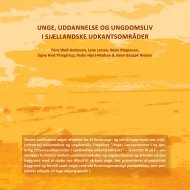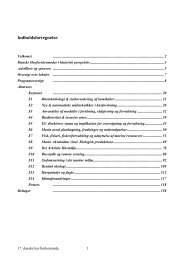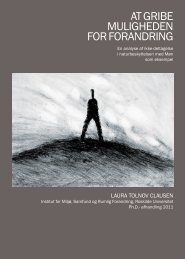what is metrotopia?
what is metrotopia?
what is metrotopia?
You also want an ePaper? Increase the reach of your titles
YUMPU automatically turns print PDFs into web optimized ePapers that Google loves.
WHAT IS METROTOPIA?<br />
• Metrotopia <strong>is</strong> a virtual city, designed and built in Second Life for a series of<br />
experiments and observations on digital communication, social interaction,<br />
design and entertainment in virtual worlds.
WHAT IS METROTOPIA?<br />
• Concept of a virtual city in which avatars can identify themselves with virtual<br />
superheroes and villains <strong>is</strong> intended to imply a sense of community between<br />
v<strong>is</strong>itors.<br />
• V<strong>is</strong>itors’ sense of belonging was supported by providing them with a pre-defined set<br />
of costumes and accessories that represent the style of comic books and sci-fi<br />
environments.
THE DESIGN PROCESS<br />
• The (ongoing) design and construction of Metrotopia has been conducted by a<br />
multi-d<strong>is</strong>ciplinary team involving freelance and in-house designers as well as<br />
researchers and consultants.<br />
• The Metrotopia project was originally undertaken by Tommy Nilsson (SL: Doctor<br />
Asp), a professional designer working in Second Life and R. Ates Gursimsek<br />
(SL: Mandal Vlodovic), industrial designer and PhD student in virtual worlds<br />
research group.<br />
• Some of the design tasks (i.e. superhero costumes) were outsourced to other<br />
designers and/or several objects inside the city were purchased from different<br />
retailers inside Second Life.
THE DESIGN PROCESS<br />
• Members of the research team also participated in the project throughout the<br />
design process in several ways.<br />
• Dr. CarrieLynn Reinhard, as the conductor of the experiment, has participated<br />
throughout the process both by evaluating the structure with regard to the purposes<br />
of her experiment, and as a member of Metrotopia Design Team.<br />
• Dr. S<strong>is</strong>se Siggaard Jensen, as the leader of the research team, has also been the<br />
member of the design team both as a consultant for the overall project, and by her<br />
experiments with virtual BOTS that would populate the city.<br />
• Dr. Dixi Lou<strong>is</strong>e Strand (research team project management) and<br />
• Ödül Akyapı Gursimsek (video production) have also been involved in the<br />
project’s final stages.
THE DESIGN PROCESS<br />
• While conceptualizing the structure of the city, generating a draft map of the locations<br />
and deciding on the functions of these locations, the research team and designers<br />
collaborated.<br />
• During these stages, several meetings, both inworld and in RL, were done in<br />
Roskilde University and/or in Metrotopia. In these meetings,<br />
– the general v<strong>is</strong>ual style of the city landscape, accessibility of specific locations and their<br />
contents were d<strong>is</strong>cussed.<br />
– the design team had opportunities to try different design possibilities and evaluate them in<br />
real time inside Metrotopia.
THE DESIGN PROCESS<br />
• In addition to the actual city parcel placed on Research Island Denmark, another<br />
platform was build 900 mt above Metrotopia<br />
• Since Second Life allows the use of Z ax<strong>is</strong> as a part of the actual parcel, the<br />
construction of virtual objects and buildings were tried out in th<strong>is</strong> workspace and<br />
placed in the city when their design <strong>is</strong> fin<strong>is</strong>hed.
THE DESIGN PROCESS<br />
• Functions of specific objects and their places were d<strong>is</strong>cussed and decided by<br />
the design team.<br />
• Nilsson and Gursimsek specified the location in the city, the dimensions and the<br />
v<strong>is</strong>ual character<strong>is</strong>tics of the designed objects/buildings (geographic position, its<br />
relation to neighboring objects, usability and attractiveness, i.e.).
THE DESIGN PROCESS<br />
• After collaboratively transforming these dec<strong>is</strong>ions to ‘design briefs’, several virtual<br />
mock-ups and alternative design solutions were generated, evaluated and<br />
modified.<br />
• 3D modeling and texturing of these buildings were also done collaboratively, and by<br />
the help of various internet material libraries and CG websites.<br />
• As the location, dimensions and main structure of the objects/buildings were decided<br />
upon, the fitting textures were searched, d<strong>is</strong>cussed and applied on the design to get<br />
the desired effect.
THE DESIGN PROCESS<br />
• Minor modifications were also done during the placement of the object, since its<br />
overall cons<strong>is</strong>tency with its surroundings <strong>is</strong> important.<br />
• The major concern at th<strong>is</strong> stage was designing a skyline view of the city that <strong>is</strong><br />
modern, clear, appealing to the v<strong>is</strong>itors and cons<strong>is</strong>tent with the context of a<br />
Superhero/heroine city.
THE METROTOPIA LOGO<br />
“The logo was designed because we want to have a specific v<strong>is</strong>ual representation for the <strong>is</strong>land for branding<br />
purposes. We want to actually create a presence in Second Life so we have a branding. And we’ll find th<strong>is</strong><br />
branding occurring all over the city ...” CarrieLynn Reinhard (Researcher, Virtual Worlds Research Group)<br />
• Reflecting the v<strong>is</strong>ual language of comic books and the superhero genre was the<br />
primary aim, along with coming up with a striking, d<strong>is</strong>tingu<strong>is</strong>hable and easily<br />
remembered logo that can be used with the other posters and graphics inside the<br />
city.
ORIENTATION / TELEPORTATION<br />
IN METROTOPIA<br />
• Orientation/teleportation posters: These posters were placed to the entrance of<br />
the city, right after welcoming arch and the costume bazaar, easing the first-time<br />
v<strong>is</strong>itor experience and strengthening the links to the v<strong>is</strong>ual language of the<br />
genre.
ORIENTATION / TELEPORTATION<br />
IN METROTOPIA<br />
• Teleport kiosks. While the form of these objects reflect the general v<strong>is</strong>ual cons<strong>is</strong>tency,<br />
the teleport kiosks also facilite orientation by reminding the v<strong>is</strong>itor the major sights to<br />
v<strong>is</strong>it and explore.<br />
• It <strong>is</strong> intended to enable participants to get familiar with the locations and their<br />
contents, so that Metrotopia <strong>is</strong> v<strong>is</strong>ited more frequently and with more users than<br />
merely the participants during the experiment.
MAJOR SIGHTS<br />
FOR INTERACTION<br />
• Although Metrotopia itself <strong>is</strong> considered as an interactive virtual environment, some<br />
regions of the city are designed purposefully to enhance the social interaction,<br />
as well as interaction with the system, in various ways and aspects. These locations<br />
are:<br />
– Costume Bazaar (and welcoming area)<br />
– Museum<br />
– Metrotopia Park/Sandbox<br />
– Gym<br />
– Fight Club<br />
• All of these places relate to a set of specific activities that the participants of the<br />
experiment are intended to experience in Second Life, such as character building,<br />
learning, design and social interaction.
COSTUME BAZAAR<br />
• The aim of th<strong>is</strong> place <strong>is</strong> first to introduce Metrotopia to the v<strong>is</strong>itor, provide information about the<br />
city’s context, and provide necessary tools for character building that <strong>is</strong> cons<strong>is</strong>tent with the overall<br />
concept.<br />
• Design of Costume Bazaar <strong>is</strong> intended to reflect the dynamic and eclectic ambience of an actual<br />
open market, with its modular design, various types of booths for separate categories of costumes<br />
and an open area for exploration and experimentation during the avatar design.
COSTUME BAZAAR<br />
• These presentation booths were designed and built in accordance with the<br />
specifications agreed on by the design team, and the final placement of the booths<br />
(the interior design of the bazaar area) was done by the collaborative work of<br />
Metrotopia Design Team.<br />
• As the team gathered together in an inworld meeting, each booth design was<br />
evaluated, and the overall placement of the various booths were d<strong>is</strong>cussed.
MUSEUM OF SUPERHEROES<br />
• The museum <strong>is</strong> designed to contain textual and audio-v<strong>is</strong>ual information on the<br />
context of the experiment and the city (Superheroes) and it <strong>is</strong> also intended to be an<br />
interactive environment.<br />
• Mainly conducted by Tommy Nilsson, the chief designer of the project, it was<br />
nonetheless a collaborative work of the design team. By the real-time modification<br />
possibilities of Second Life, inworld meetings were also used for real-time<br />
modification of the space design, such as application of different textures and<br />
placement of information surfaces.
MUSEUM OF SUPERHEROES<br />
• The general complexity of the design was considered not only as a problem of<br />
how the content was selected and presented, but also by the ways to travel<br />
and explore the virtual place provided for the v<strong>is</strong>itors.<br />
• Teleport kiosks, which enable the v<strong>is</strong>itor to directly arrive in the top floors and<br />
then, fly or walk around the desired region were placed inside the Museum.
METROTOPIA PARK<br />
SANDBOX<br />
• Metrotopia Park <strong>is</strong> also a sandbox, which means a rezzing/building-free zone for all<br />
v<strong>is</strong>itors regardless of their being a member of the owner group of Research Island<br />
Denmark.<br />
• The objective behind the idea of including a Sandbox in the Metrotopia was their role<br />
in enabling v<strong>is</strong>itors to experience building and experimenting with virtual objects;<br />
thus, providing a platform for user participation through user-generated content.
METROTOPIA PARK<br />
SANDBOX<br />
• The sandbox idea and the park coincides in their basic structure, in that they both require open<br />
spaces that allow v<strong>is</strong>itors to travel inside freely and facilitate social interaction.<br />
• There are several components of the park/sandbox that are placed purposefully, in order to<br />
enhance social interaction. The children's playground, which involves interactive virtual toys <strong>is</strong><br />
one of these specific locations. Other interactive components include the Freudian Bench, the<br />
Hot-dog Cart.
RESIDENTIAL AREA<br />
• The north-east corner of Metrotopia cons<strong>is</strong>ts of several middle-sized buildings that<br />
are organized to be connected by narrow streets and a dead-end back alley.<br />
• The residential area was organized to facilitate surpr<strong>is</strong>e effects and provocation,<br />
mainly by the future implementation of BOTs attacking the v<strong>is</strong>itors individually or in<br />
groups.
PROVING GROUND GYM<br />
• Proving Ground Gym offers v<strong>is</strong>itors several interactive experiences, from<br />
training in one of the many exerc<strong>is</strong>e machines to gaining new superhero<br />
skills and taking commemorative snapshots.
PROVING GROUND GYM<br />
• At the east entrance of the gym, a large box with a striking “Click for Your<br />
Superpowers!” banner stands for providing the v<strong>is</strong>itors with a number of animated<br />
superhero abilities (i.e. colorful bubbles flying randomly around the avatar, lightning<br />
or fire effects).<br />
• Posing Studio, which lies on top of the Proving Ground gym building, offers a place<br />
where avatars, who fully transformed into their superhero characters with their<br />
costumes, training, and animated skills, can take snapshots of their characters.
FIGHT CLUB DOJO<br />
• Across the residential area, to the southeast of the city, a harbor-like area was<br />
designed to contain the Fight Club Dojo. V<strong>is</strong>ually, th<strong>is</strong> area differentiates from other<br />
parts of the <strong>is</strong>land mainly by its rusty and industrial form.<br />
• Fight Club Dojo <strong>is</strong> the place where v<strong>is</strong>itors can challenge each other by using various<br />
weapons (guns, light sabers, hand grenades, i.e.) or practice the use of these<br />
weapons in a shooting range.
FIGHT CLUB DOJO<br />
• Here it <strong>is</strong> aimed to provide v<strong>is</strong>itors with necessary tools for interaction in a clear and user<br />
friendly manner, and enhance the superhero genre concept by implying the challenging nature<br />
of the place.<br />
• For increasing players’ immersion into the game, the parcel on which Fight Club stands was<br />
modified to contain health/hit points for each player. As one player gets shot enough to reduce<br />
her hit points to zero, the player <strong>is</strong> teleported into her home location (as a representation of<br />
inworld death).
FIGHT CLUB DOJO<br />
• An interactive shooting range placed in the northeast corner of the building. Th<strong>is</strong> game has 3<br />
difficulty levels, the high scores of which are kept in its memory<br />
• Fight Club <strong>is</strong> also a Sandbox, where the v<strong>is</strong>itors can build or rez objects from their inventories<br />
and use. Th<strong>is</strong> feature also enables the players to create new objects with which they can modify<br />
the space for their fight, or create virtual enemies (bots, animated objects, i.e.) to play against.<br />
• Th<strong>is</strong> also enforces user generated design and innovation, and increases participation.


